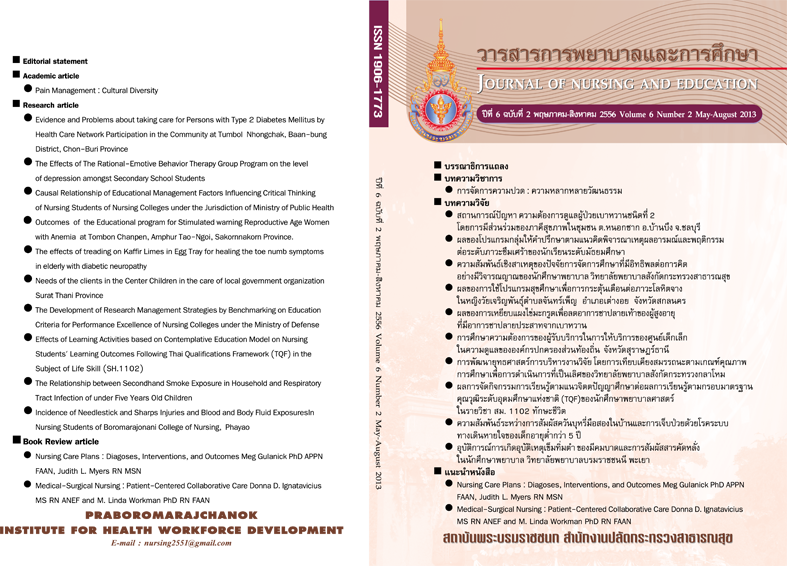ความสัมพันธ์ระหว่างการสัมผัสควันบุหรี่มือสองในบ้าน และการเจ็บป่วยด้วยโรคระบบทางเดินหายใจของเด็กอายุต่ำกว่า 5 ปี*
คำสำคัญ:
respiratory tract infection, secondhand smoke, childrenบทคัดย่อ
บทคัดย่อ
การศึกษาวิจัยเชิงพรรณนา (Descriptive Study) นี้มีวัตถุประสงค์เพื่อศึกษาการสัมผัสควันบุหรี่มือสองของเด็กอายุต่ำกว่า 5 ปี และศึกษาความสัมพันธ์ของการสัมผัสควันบุหรี่มือสองในบ้านและการเจ็บป่วยด้วยโรคระบบทางเดินหายใจของเด็กอายุต่ำกว่า 5 ปี ในครัวเรือน ชุมชนช้างเผือก อ.เมือง จ. นครราชสีมา
การเก็บข้อมูลโดยใช้แบบสัมภาษณ์กับกลุ่มตัวอย่าง ได้แก่ พ่อ แม่ หรือผู้ดูแล และเด็กอายุต่ำกว่า
5 ปี ในชุมชนช้างเผือก อ.เมือง จ.นครราชสีมา จำนวน 80 คน วิเคราะห์ข้อมูลโดยสถิติเชิงพรรณาและสถิติวิเคราะห์ เพื่อทดสอบความสัมพันธ์ของการสัมผัสควันบุหรี่มือสองกับการเจ็บป่วยด้วยโรคระบบทางเดินหายใจโดยใช้สถิติ ไค-สแควร์ (Chi-Square Test)
ผลการวิจัยพบว่าผู้ให้ข้อมูลส่วนใหญ่เป็นเพศหญิง ร้อยละ 67.50 อายุอยู่ระหว่าง 22-40 ปี ร้อยละ 52.50 สถานภาพสมรสคู่ ร้อยละ 87.50 มีระดับการศึกษาอยู่ระดับชั้นประถมศึกษา ร้อยละ 51.25 นับถือศาสนาพุทธ ร้อยละ 97.50 ประกอบอาชีพรับจ้างทั่วไป ร้อยละ 33.80 และมีรายได้ต่อเดือนอยู่ระหว่าง 5,000-10,000 บาท ร้อยละ 48.75 โดยเด็กส่วนใหญ่เป็นเพศชายคิดเป็น ร้อยละ 62.22 มีอายุอยู่ระหว่าง 2-3 ปี
ร้อยละ 40.74 และในสามเดือนที่ผ่านมาเด็กอายุต่ำกว่า 5 ปี เจ็บป่วยด้วยโรคหวัดมากที่สุด ร้อยละ 91.84
มีสมาชิกในบ้านที่ได้สัมผัสควันบุหรี่มือสองจำนวน 70 ครัวเรือน คิดเป็น ร้อยละ 87.50 โดยสูบบุหรี่ในบ้าน ร้อยละ 47.14 ผู้ที่สูบบุหรี่ในบ้านมากที่สุดคือพ่อ ร้อยละ 55.71 โดยเฉลี่ยสูบวันละ 11 มวน และ
สูบขณะมีเด็กอายุต่ำกว่า 5 ปี อาศัยอยู่ด้วยร้อยละ 70 จากการทดสอบความสัมพันธ์ของการสัมผัสควันบุหรี่มือสองในบ้าน และการเจ็บป่วยด้วยโรคระบบทางเดินหายใจ (Chi-Square Test) พบว่าการสัมผัสบุหรี่มือสองของเด็กอายุต่ำกว่า 5 ปี มีความสัมพันธ์กับการป่วยด้วยโรคระบบทางเดินหายใจ อย่างมีนัยสำคัญทางสถิติ (X2 = 18.2 , p < .001)
ผลการวิจัยครั้งนี้พบว่าเด็กอายุต่ำกว่า 5ปี ในชุมชนช้างเผือกมีการสัมผัสควันบุหรี่มือสองเป็นจำนวนมากและสัมพันธ์กับการเจ็บป่วยด้วยโรคระบบทางเดินหายใจ ดังนั้นพยาบาลหรือบุคลากรสาธารณสุขที่รับผิดชอบ จึงควรตระหนักในการส่งเสริมให้สมาชิกในครอบครัวโดยเฉพาะพ่อให้หยุดการสูบบุหรี่ในบ้าน เพื่อลดอัตราการเกิดโรคระบบทางเดินหายใจในเด็กต่อไป
คำสำคัญ : โรคระบบทางเดินหายใจ ควันบุหรี่มือสอง เด็กอายุต่ำกว่า 5 ปี
Abstract
The purposes of this research were to study the secondhand smoke exposure of children under five years old and to examine whether secondhand smoke exposure correlate with respiratory tract infection of children under five years old in Changphuek Community, Nakhonratchasima. The eighty purposive samples were interviewed by researcher following the secondhand smoke exposure of
children under five years old questionnaire. Descriptive statistics and Chi-Square Test were used for analyzing.
This descriptive study found that the majority of participants were female, age 22-40 years old, married, completed in primary school, Buddhist, monthly income 5,000-10,000 baht. Children in household were male, 62.22 percents, and age 2-3 years old, 40.74 percents. In the past three months, those children had a common cold 91.84 percents. Almost ninety percent of household (n=70) in Changphuek community reported there was secondhand smoke exposure in their house. The majority of smokers in the household were father, 55.71 percents. The participants, 47.14 percents, reported the smokers smoke inside their house, daily smoke 11 cigarettes in average, and seventy percents of them smoke when children stayed in the house. There was correlation between secondhand smoke exposure and respiratory tract infection (X2 = 18.2, p ? .001),that means, children under five years old who exposed to secondhand smoke will have respiratory tract infection.
The findings of this study indicated that children under five years old expose to secondhand smoke in their household. For protecting them from respiratory tract infection, nurses should concern this situation and plan to help family members reduce or stop smoking inside their houses.
Keywords : respiratory tract infection, secondhand smoke, children





